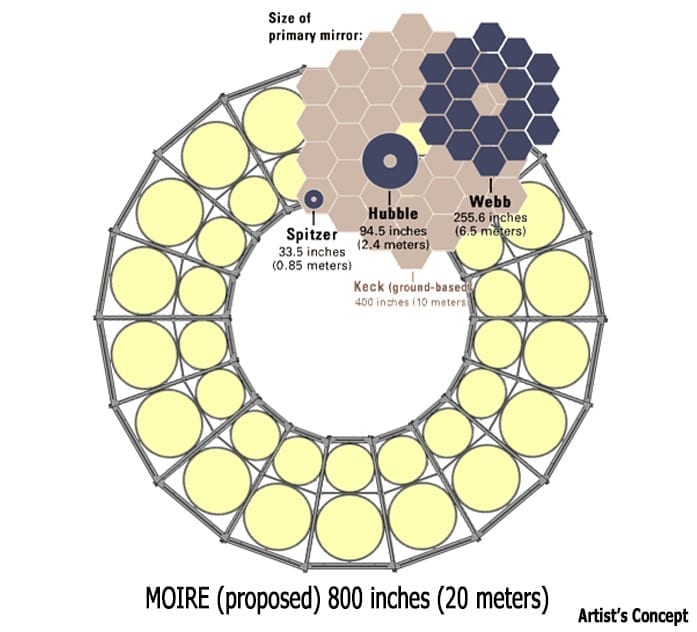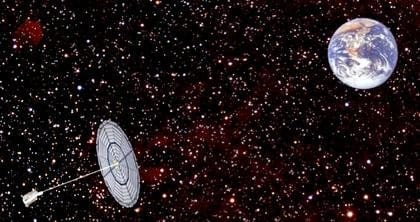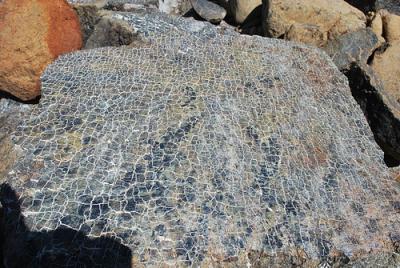
A satellite using MOIRE optics could see approximately 40 percent of the earth’s surface at once
The capability of orbital telescopes to see wide swaths of the earth at a time has made them indispensable for key national security responsibilities such as weather forecasting, reconnaissance and disaster response. Even as telescope design has advanced, however, one aspect has remained constant since Galileo: using glass for lenses and mirrors, also known as optics. High-resolution imagery traditionally has required large-diameter glass mirrors, which are thick, heavy, difficult to make and expensive. As the need for higher-resolution orbital imagery expands, glass mirrors are fast approaching the point where they will be too large, heavy and costly for even the largest of today’s rockets to carry to orbit.
DARPA’s Membrane Optical Imager for Real-Time Exploitation (MOIRE) program seeks to address these challenges. MOIRE aims to create technologies that would enable future high-resolution orbital telescopes to provide real-time video and images of the Earth from Geosynchronous Earth Orbit (GEO)—roughly 22,000 miles above the planet’s surface. Size and cost constraints have so far prevented placing large-scale imaging satellites in GEO, so MOIRE is developing technologies that would make orbital telescopes much lighter, more transportable and more cost-effective.
Currently in its second and final phase, the program recently successfully demonstrated a ground-based prototype that incorporated several critical technologies, including new lightweight polymer membrane optics to replace glass mirrors. Membrane optics traditionally have been too inefficient to use in telescope optics. MOIRE has achieved a technological first for membrane optics by nearly doubling their efficiency, from 30 percent to 55 percent. The improved efficiency enabled MOIRE to take the first images ever with membrane optics.
While the membrane is less efficient than glass, which is nearly 90 percent efficient, its much lighter weight enables creating larger lenses that more than make up the difference. The membrane is also substantially lighter than glass. Based on the performance of the prototype, a new system incorporating MOIRE optics would come in at roughly one-seventh the weight of a traditional system of the same resolution and mass. As a proof of concept, the MOIRE prototype validates membrane optics as a viable technology for orbital telescopes.
“Membrane optics could enable us to fit much larger, higher-resolution telescopes in smaller and lighter packages,” said Lt. Col. Larry Gunn, DARPA program manager. “In that respect, we’re ‘breaking the glass ceiling’ that traditional materials impose on optics design. We’re hoping our research could also help greatly reduce overall costs and enable more timely deployment using smaller, less expensive launch vehicles.”
Instead of reflecting light with mirrors or refracting it with lenses, MOIRE’s membrane optics diffract light. Roughly the thickness of household plastic wrap, each membrane serves as a Fresnel lens—it is etched with circular concentric grooves like microscopically thin tree rings, with the grooves hundreds of microns across at the center down to only 4 microns at the outside edge. The diffractive pattern focuses light on a sensor that the satellite translates into an image.
MOIRE technology houses the membranes in thin metal “petals” that would launch in a tightly packed configuration roughly 20 feet in diameter. Upon reaching its destination orbit, a satellite would then unfold the petals to create the full-size multi-lens optics. The envisioned diameter of 20 meters (about 68 feet) would be the largest telescope optics ever made and dwarf the glass mirrors contained in the world’s most famous telescopes.
From GEO, it is believed, a satellite using MOIRE optics could see approximately 40 percent of the earth’s surface at once. The satellite would be able to focus on a 10 km-by-10 km area at 1-meter resolution, and provide real-time video at 1 frame per second.
via DARPA
The Latest on: Space Telescope
- China's 'lobster eye' Einstein telescope releases 1st batch of trippy space imageson May 3, 2024 at 6:00 am
Flaring stars, black hole outbursts and gamma-rays are just some of the cosmic exotica that Einstein Probe will hunt for.
- AI discovers over 27,000 overlooked asteroids in old telescope imageson May 2, 2024 at 2:03 am
Just two weeks ago, for instance, citizen scientists spearheaded training of an algorithm that led to the discovery of 1,000 new asteroids in archival images clicked by the Hubble Space Telescope. Last July, a software named HelioLinc3D designed to hunt ...
via Bing News
The Latest on: Membrane Optical Imager for Real-Time Exploitation
- Researchers unveil single-shot and complete polarization imaging system using metasurfaceson May 2, 2024 at 8:03 am
Think of all the information we get based on how an object interacts with wavelengths of light—aka color. Color can tell us if food is safe to eat or if a piece of metal is hot. Color is an important ...
- E-Gel Safe Imager Real-Time Transilluminator from Thermo Scientificon April 27, 2024 at 5:00 pm
The use of SYBR ® Safe DNA Gel Stain and a Safe Imager™ Transilluminator ensures maximum possible safety to the user and gives improved cloning efficiency over ethidium bromide and UV.
- Simplified diagnosis of rare eye diseaseson April 24, 2024 at 5:00 pm
Fundus autofluorescence (FAF) is a fast and non-invasive imaging technique that supports this. Researchers have drafted a review on how FAF can facilitate the diagnosis and monitoring of posterior ...
- Optical Illusion: Can you find the seashell in this underwater image?on April 23, 2024 at 12:30 am
Optical illusion tests enhance problem-solving ... Consider this one, though not as advanced, as a virtual deep dive. The image that's been provided below essentially shows some amazing marine ...
- Best cheap cameras in 2024on April 17, 2024 at 7:04 am
The PixPro AZ421 has a 3.0-inch 460k-dot rear LCD display (but no touchscreen), optical image stabilization (though you'll still want a tripod), and an ISO range of 80-3200. There are some ...
- Optical Illusion Personality Test: What's Your Biggest Fear? Let This Image Reveal the Truthon March 31, 2024 at 9:53 am
The optical illusion personality test is a journey into understanding yourself better. It reveals your fears, desires, and traits based on what you see first in a tricky image. This test combines ...
- Modern Information Optics with MATLABon March 28, 2024 at 2:06 am
and demonstrate MATLAB codes to accomplish tasks such as optical image processing and pattern recognition. This title is a comprehensive introduction to the basics of Fourier optics as well as optical ...
- Membrane invagination induced by Atg8-E1-E2-E3 (IMAGE)on December 20, 2023 at 2:09 am
Autophagosomes are formed by membrane expansion and invagination, during which intracellular proteins, organelles, etc. are sequestered into autophagosomes. The sequestered materials are degraded ...
- Research Applicationson August 4, 2023 at 12:25 pm
However, its resolution is limited in wavelength to approximately 0.5 millimeters. Imaging with optical polarized light offers higher resolution (comparable to histology) but lacks the contrast. This ...
via Bing News










